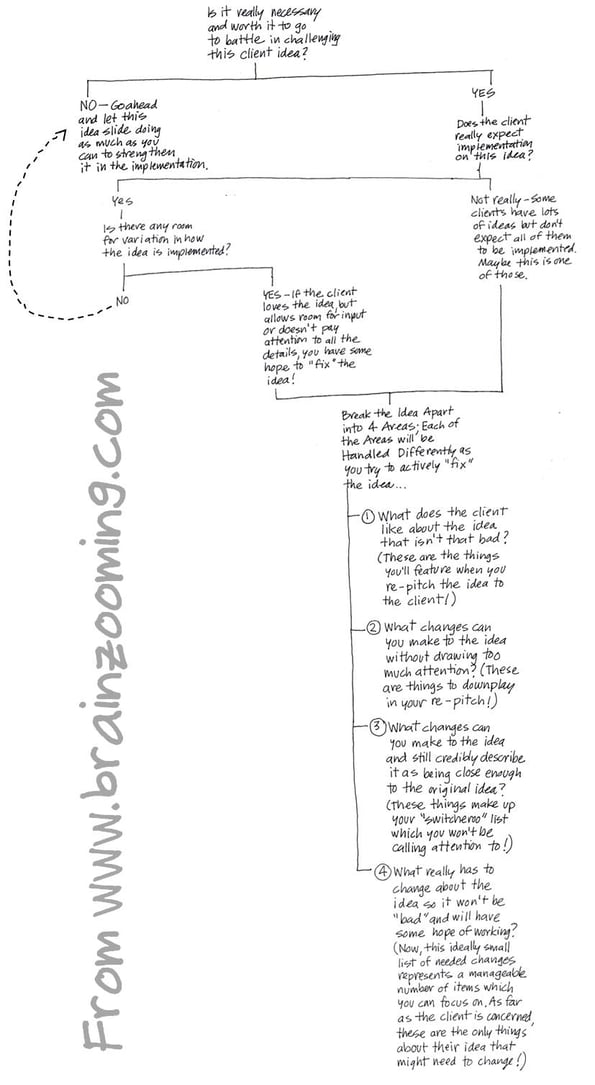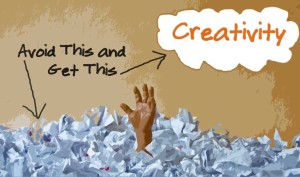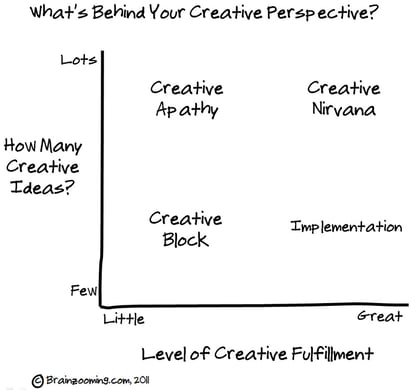What can you do in managing clients who love their own creative ideas?
My comment on sometimes working toward a creative objective without letting others know what's happening, triggered this more specific CreativeBloc question about successfully managing a client (and the client's ego) when they love their own creative ideas.
While the question isn't specific, I'm figuring it's referencing when there are issues with an idea's quality, efficacy, implementation, etc. Absent fundamental issues, don't rule out a creative idea simply because it originated with a client who loves it. (Trust me, as a client, I had agencies do this. It's infuriating when they don't come to the table with creative ideas that are any stronger.)
Here's how I go about challenging an idea when somebody loves it a little too much:
Step 1 - Diagnose the Situation
Start by understanding the client's opinions, motivations, and foundation for loving the idea. Do this through:
- Making sure you're completely clear on what the client thinks the primary objective is the creative idea needs to successfully address.
- Asking questions (or simply letting the client talk) about what works with the idea. Carefully and strategically probe to see both what personal preferences AND potential concerns exist (if any) about the idea for the client.
- Discussing how and how well the client's idea meets the primary objective. This will provide a sense of potential areas you'll need to support and where you can counter an idea.
- Reaching out to others who understand the client's thinking patterns, what's important to them personally and organizationally, and when they will and won't be open to compromise.
Step 2 - Analyze What You Know
Once you'd done your homework, analyze and size up the situation. Understand what elements really need changing vs. those you'd simply like to change. Figure out whether a factual or emotional argument might be more successful. Develop a couple of hypotheses on how the conversation(s) might go with the client.
Step 3 - Plan Your Strategy
At Step 3, I usually map out what my options are to try and move this type of situation to the best one for the business. This mapping out usually involves blank sheets of paper, a marker, and some time to draw out the options I'll pursue and what could happen at each stage. To give you a feel for what that might be like, here's how I'd map out my strategy for trying to move a client from their favorite idea to some alternative. Based on the situation, I might give up right away (if it's just not that big a deal) or could develop a multi-tiered case that calls attention to what's identical in the alternative I'm approaching and try to minimize the number of critical issues where the client's opinion has to be swayed.
 One caveat - I've found the intensity of my counter arguments has changed since leaving corporate life. Where I had to live with the outcome of bad decisions, I was much more likely to be strident in making my case. It's been a source of personal development working with clients, however, to realize that ultimately they have to live with the implications of an idea - positive or negative. Because of that, I'll pull up on counter arguments much sooner than I would have in the past.
One caveat - I've found the intensity of my counter arguments has changed since leaving corporate life. Where I had to live with the outcome of bad decisions, I was much more likely to be strident in making my case. It's been a source of personal development working with clients, however, to realize that ultimately they have to live with the implications of an idea - positive or negative. Because of that, I'll pull up on counter arguments much sooner than I would have in the past.
Also, I didn't go into waging an all-out battle to defeat an idea here. That's certainly a strategy, but it's one worth avoiding! It's hardly ever productive for the client or anyone else involved in the situation.
On Monday, we'll have the final post in this series, touching on whether everybody needs to be a creative thinker. – Mike Brown
If you’d like to add an interactive, educationally-stimulating presentation on strategy, innovation, branding, social media or a variety of other topics to your event, Mike Brown is the answer. Email us at brainzooming@gmail.com or call 816-509-5320 to learn how Mike can get your audience members Brainzooming!



